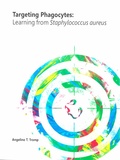Targeting phagocytes
Learning from Staphylococcus aureus
Summary
The staphylococcal bi-component leukocidins Panton-Valentine Leukocidin (PVL) and γ-hemolysin CB (HlgCB) target human phagocytes. Binding of the toxins’ S-components to human C5aR1 contributes to cellular tropism and human specificity of PVL and HlgCB. To investigate the role of both leukocidins during infection, we developed a human C5aR1 knock-in (hC5aR1KI) mouse model. HlgCB but, unexpectedly, not PVL contributed to increased bacterial loads in tissues of hC5aR1KI mice. Compared to humans, murine hC5aR1KI neutrophils showed a reduced sensitivity to PVL, which was mediated by the toxin’s F-component. By performing a genome-wide CRISPR/Cas9 screen, we identified CD45 as the first F-component leukocidin receptor, along with multiple other genes involved primarily in the post-translational modification of proteins. Human-specific interaction with CD45 provides a molecular explanation for resistance of hC5aR1KI mouse neutrophils to PVL and likely contributes to the lack of a PVL-mediated phenotype during infection in these mice. Consequently, other S. aureus bi-components toxins might also designate both S- and F-component to increase host/cell specificity. Furthermore, sulfation and sialylation of both S- and F-component targets determine susceptibility to PVL and HlgCB. These post-translational modifications might not be limited to the C5aR1-targeting leukocidins, but essential for the interaction between all bi-component S-component and their corresponding G-protein coupled receptor (GPCR) targets. Understanding and knowledge of the mechanisms of action of PVL and other human specific toxins could not only identify new targets that could be exploited for anti-virulence strategies to limit S. aureus infections, but also improve current in vivo infection models.
